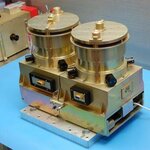Aerospace

NASA's Hubble Space Telescope has found the farthest supernova so far. Supernova UDS10Wil, nicknamed SN Wilson after American President Woodrow Wilson, exploded more than 10 billion years ago.
SN UDS10Wil is a Type Ia supernovae. These beacons can be used as a yardstick for measuring cosmic distances. One of the debates surrounding Type Ia supernovae is the nature of the fuse that ignites them. This latest discovery adds credence to one of two competing theories of how they explode. Although preliminary, the evidence so far favors the explosive merger of two burned out stars; small, dim, and…

The first published results from the Alpha Magnetic Spectrometer (AMS) physics experiment on the International Space Station were announced today and though the result is the most precise measurement to date of the ratio of positrons to electrons in cosmic rays, we still have not caught our first glimpse into dark matter.
The AMS experiment, constructed at universities around the world and assembled at the European Organization for Nuclear Research (CERN), is the world's most precise detector of cosmic rays. It was installed on the Space Station May 19th, 2011 after having been brought…

Thanks to a supersensitive space telescope and some sophisticated supercomputing, scientists from the international Planck collaboration have made the closest reading yet of the most ancient story in our universe: the cosmic microwave background (CMB).
Today, the team released preliminary results based on the Planck observatory's first 15 months of data. They show that the universe is 100 million years older than we thought with more matter and less dark energy.
Decoding the Cosmos
Written in light shortly after the big bang, the CMB is a faint glow that permeates the cosmos. Studying…

The mission of the ESA Planck satellite is to observe the Universe of the past, seeing back in time, right after the Big Bang.
The image that the Planck scientists revealed today is that of the Universe as a child, dating back to about 380,000 years after the Big Bang, when its temperature was similar to that of the most external layer of a star today.
The Planck satellite was launched in May 2009 and has been observing the Universe's fossil radiation. In Trieste scientists have analyzed data delivered by the LFI (Low Frequency Instrument), the instrument that detects the radiation within…

Beginning a few years ago, speculation began about when Voyager I would leave the solar system. There was no sure way to know, the solar system has no official boundary, so scientists were looking for signs.
35 years after its launch, it seems Voyager 1 appears to have traveled beyond the influence of the Sun and exited the heliosphere, the region of space dominated by the Sun and its wind of energetic particles, and which is thought to be enclosed, bubble-like, in the surrounding interstellar medium of gas and dust that pervades the Milky Way galaxy.
On August 25, 2012, NASA…

For a government that likes military action but not losing American lives, drones are the next big thing. Drones have been, and will continue to be, used in more and more applications outside the military, including citizen surveillance and natural disaster research.
But military spending is what is driving optimization and the U.S. Department of Defense reports that drone accidents happen 50 times more often than mishaps involving human-operated aircraft. The U.S. Army and U.S. Marine Corps reported 43 mishaps that involved human factors issues associated with drone ground…

NASA is hosting a news teleconference to announce black hole observations from its newest X-ray telescope, the Nuclear Spectroscopic Telescope Array (NuSTAR), and the European Space Agency's XMM-Newton X-ray telescope.
This is obviously big news and has been hinted at for a while. Check it out.
The briefing participants are:
-- Fiona Harrison, NuSTAR principal investigator, California Institute of Technology, Pasadena, Calif.
-- Guido Risaliti, astronomer, Harvard-Smithsonian Center for Astrophysics, Cambridge, Mass., and the Italian National Institute for Astrophysics
-- Arvind Parmar,…

Chelyabinsk Meteor Waves Largest Ever Detected By Comprehensive Nuclear-Test-Ban Treaty Organization
Infrasonic waves from the meteor that broke up over over Chelyabinsk in Russia's Ural mountains last week were the largest ever recorded by the Comprehensive Nuclear-Test-Ban Treaty Organization's (CTBTO) International Monitoring System. The blast was detected by 17 infrasound stations in the CTBTO's network, which tracks atomic blasts across the planet. The furthest station to record the sub-audible sound was 15,000 km away in Antarctica.
Infrasound has been used as part of the CTBTO's tools to detect atomic blasts since April 2001 when the first station came online in Germany.…

NASA has got the hang of it now. Creating an almost unbearable suspense before the launching of a new satellite, that is. Actually, the last time NASA tortured us with excitement was in connection with a landing, and not a launching. I am of course referring to Curiosity's landing on Mars. That went well, to put it mildly. Both the 'show' and now the results that are ticking in from the mission. Currently it is drill baby, drill mode on Mars!
Landsat 8 drawing. Credit: NASA
Back on Earth, today Landsat 8 is about to be launched. I will be following that live, and so should you. Adding to the…

Some time this month, in Poker Flat, Alaska, a team of scientists from The Aerospace Corporation of El Segundo, Calif.and NASA's Goddard Space Flight Center of Greenbelt, Md., will launch a sounding rocket up through the Northern Lights.
The VISIONS (VISualizing Ion Outflow via Neutral atom imaging during a Substorm) rocket will soar high through the arctic sky to study the auroral wind, which is a strong but intermittent stream of oxygen atoms from Earth's atmosphere into outer space. It will survive fifteen minutes before splashing down in the Arctic Ocean but the information it…